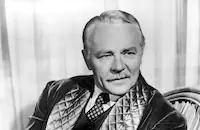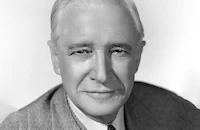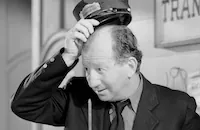The Big Broadcast of 1936

Brief Synopsis
Cast & Crew
Norman Taurog
Jack Oakie
George Burns
Gracie Allen
Lyda Roberti
Henry Wadsworth
Film Details
Technical Specs

Synopsis
Spud Miller runs radio station W.H.Y. with his partner Smiley and two young performers, Dot and Dash, but he is about to lose the station due to lack of funds. Entrepreneurs George and Gracie try to sell Spud the "Radio Eye," a contraption that picks up broadcasts and events all over the world and projects them on a viewing screen. Spud keeps the machine, planning to use it for his own broadcasts. He also receives his acceptance notice from the International Broadcasting Competition for his station to compete for the best broadcast. Spud's radio personality attracts Countess Ysobel De Nargila, who goes to the station and discovers that the radio personality known as "Lochinvar," is actually Spud's speaking voice and Smiley's singing voice. Determined to fall in love and marry one of them, Ysobel kidnaps them and takes them south of the border on her yacht to her island country, Clemente. Ysobel's secretary Sue has fallen in love with Smiley and warns him that Gordoni, the caretaker of Ysobel's plantation, is dangerously jealous and has killed all of Ysobel's previous suitors. The next night, Spud and Smiley find out Gordoni plans to kill them at midnight, and they call for help using the Radio Eye. In response, George and Gracie row for Clemente and are rescued by a passing boat. In the meantime, Spud and Smiley frantically try to buy time by broadcasting their story over the Radio Eye and using the images they pick up on the screen to entertain Ysobel so she does not fall asleep, as they are aware that as soon as she falls asleep, Gordoni will attempt to kill them. As they are doing this, the broadcasting competition picks up their transmission and assumes it is their entry in the contest. Midnight strikes, Spud cries for help and a fight ensues. Spud and Smiley take off on a horsedrawn carriage with Gordoni's men in hot pursuit. The carriage and horses separate, and the carriage stops short of plunging into the ocean just as the U.S. Marines arrive. Spud discovers Gordoni inside the carriage, but Gordoni falls into the ocean. Spud is reunited with Ysobel, and Sue is united with Smiley as they all find out that W. H. Y. won the broadcasting competition.

Director

Norman Taurog
Cast

Jack Oakie

George Burns

Gracie Allen

Lyda Roberti

Henry Wadsworth

Wendy Barrie

C. Henry Gordon

Akim Tamiroff
The Nicholas Brothers

Bing Crosby
Amos 'n' Andy

Ethel Merman
Sir Guy Standing
David Holt

Gail Patrick

Bill Robinson
Benny Baker
Ina Ray Hutton And Her Melodears
Vienna Boys Choir
Ray Noble And His Band

Mary Boland

Charles Ruggles

Samuel S. Hinds
Richard Alexander
Charles Hamilton
Arthur Aylesworth
Leon Holmes
Suzanne Kaaren
Virginia Bassett
Mildred Gover

Hank Mann
Peggy Watts
Phyllis Lee
Judith Vosselli
Al Thompson
William Irving
Stanley Andrews
Arthur Stuart Hull
Jack Mulhall
Larry Wheat
Mabel Forrest
Tom Hanlon
Billy Engle

Virginia Weidler
Lillian Harmer
Edward Lesaint
Will West And Mcginty
Betty Jane Cooper And The Lathrop Brothers
Fox And Walters
Richard Tauber
Carlos Gardel
Jessica Dragonette
Crew
Roland Asher
Claire Behnke
David Boehm
"beans" Bonedel
Ray Camp
J. N. Cope
Walter Deleon
Carmen Dirigo
Hans Dreier
Andy Durkis
Farciot Edouart
Julius J. Epstein
Nathaniel Finston
Mary Flannery
Carlos Gardel
Grant Garrett
Benjamin Glazer
Stanley Goldsmith
Mack Gordon
Bert Granger
Hazel Haggerty
Harry Hallenberger
Bert Hanlon
Marjorie Harper
Henry Herzbrun
Ellsworth Hoagland
F. T. Hoffman
Jim Hunter
Al Hurley
Ralph Huston
Arthur Jacobson
Gordon Jennings
Joe Keller
Art Lane
Alfredo Le Pera
Alma Macrorie
George Marion Jr.
Francis Martin
J. P. Mcevoy
John P. Medbury
E. P. Merritt
Gene Merritt
Jack Mintz
Eddie Montagne
Paul Moss
Henry Myers
Ray Noble
Dorothy Parker
S. J. Perelman
Frank Pheney
Lou Pitt
Leroy Prinz
Ralph Rainger
Ted Reed
Harry Revel
Leo Robin
Harry Ruskin
Heinrich Schuster
Mel Shauer
John Smirch
Ralph Spence
George Stoll
Jane Storm
James Tait
Leo Tover
Robert Usher
William Walling Jr.
Eddie Welch
Richard A. Whiting
Stanley Williams
Adolph Zukor

Film Details
Technical Specs

Award Nominations
Best Dance Direction
Articles
Big Broadcast of 1936 -
During the 1930s, Paramount Pictures produced the Big Broadcast series, which was centered around the radio industry and featured signature performances by popular radio stars. The original Big Broadcast was released in 1932, and it was followed by three other entries in the series, including The Big Broadcast of 1936 (1935). The formulaic plots began with the station in financial trouble, followed by events designed to lift the station back on its feet. Many of these events consist of performances by a variety of radio and film stars. The films concluded with a glorious vaudeville-style finale to celebrate the station's solvency. Initially, the Hollywood industry may have felt competition from radio, because it gave audiences entertainment for free. However, the studios quickly learned to use radio to support and promote their films and stars, creating a synergy that benefitted both mediums. The Big Broadcast musicals were financially successful for Paramount.
The Big Broadcast of 1936 stars Jack Oakie as Spud Miller, owner of second-rate, financially strapped station W.H.Y. He broadcasts love sonnets and sings ballads as Lochinvar, the Great Lover, though the singing is actually done by his sidekick, Smiley, played by Henry Wadsworth. Two plot threads are used to weave together the performances by the musical guest stars. Spud pursues Countess Ysobel de Naigila, a ditzy socialite played by Lyda Roberti. The Countess takes Spud and Smiley to the private island of plantation owner Gordoni, who is jealous of her attentions to Spud. In the meantime, Spud is in possession of a machine called the Radio Eye, an invention developed by George Burns and Gracie Allen, who play themselves. The Radio Eye is an exaggerated television set, which, according to George, can receive "anything anytime . . . whether the events are broadcast or not." The invention with its bizarre reception capabilities provides an excuse in the plot to introduce performers as diverse as the Vienna Boys Choir and Ethel Merman, but its similarities to television suggest that TV was becoming part of the cultural consciousness. In 1929, Vladimir Zworkin had used a kinescope tube to demonstrate the first practical electronic system for the transmission and reception of images; the first television studio opened that same year; and, in 1933, a radio station in Iowa began broadcasting two television programs twice a week. The time was ripe to reference and even lampoon this new broadcast medium. Burns and Allen appeared in three of the four Big Broadcast films, including the original in 1932. In The Big Broadcast of 1936, they costarred as characters who figured into the storyline, though they also performed their own original material. Burns and Allen had developed their act and show-business personas in vaudeville, becoming successful in 1925-1926 on the Orpheum Circuit. Their act was a version of a Dumb Dora routine, which was a male-female act in which the woman appeared to be ditzy or dimwitted. The male, who was the straight man, engaged the woman in conversation, asking her questions and soliciting her opinion. As the routine continued, it became clear that the female was not always as dumb as she seemed. She merely had a unique perspective, responded to the situation in a different way, or misunderstood the question because she took it literally. This vexed the straight man, and his frustrations are part of the humor. Typically, the Dumb Dora archetype was a chorus girl, usually dressed in a sexy, flamboyant costume. Gracie Allen varied the archetype by eliminating the sexy angle and playing her as a sweet, tastefully dressed woman. Her character, Gracie, in The Big Broadcast of 1936 is arguably more dimwitted than usual, but the film showcases Allen's persona, particularly the way her actions and perspective are usually validated. In one scene, George and Gracie are adrift at sea in a rowboat. While George is pre-occupied, Gracie sets the oars on fire in order to burn up some knitting she does not want. George rants and raves when he discovers what she has done and why, but the fire results in their rescue because it attracts the attention of the coast guard, and the two are saved.
Another team of entertainers who received screen time as characters were the Nicholas Brothers. Fayard Nicholas was only 20 and his brother Harold 14 when they costarred as Dot and Dash, assistants to Spud Miller at W.H.Y. Harold croons a ballad and scats during a jazz number, while Fayard plays multiple instruments. They also tap dance in their trademark fast-paced style that includes a variety of stunts and acrobatics. Their dance number provides one of the film's most interesting sequences. As the camera moves in on Harold's feet, the scene cuts to a different pair of feet following the same steps. The feet belong to Bill "Bojangles" Robinson, who is sitting in a barber's chair. He gets up and dances down the street in his light-footed, upright style, which differs from the acrobatics and lightning pace of the Nicholas Brothers. Robinson was credited with bringing tap up on its toes compared to the earlier flat-footed, shuffling style of early vaudeville and minstrel shows. At the end of Robinson's number, the scene cuts back to Harold's feet, suggesting the influence of one generation of dancers on another and the evolution of tap. On a side note, the Singing Sisters who appear in Robinson's number are the Dandridge Sisters, consisting of Dorothy and Vivian Dandridge and Etta Jones.
Most performers were shown via the Radio Eye, appearing in one scene that showcased their act. Movie stars Charles Ruggles and Mary Boland perform in a comedy skit about the frustrations of married life. This unlikely romantic team would star in 14 films all together as husband and wife, and in 1935, they were riding a wave of popularity after their hit comedy Ruggles of Red Gap was released in February of that year. Comic actor Benny Baker shared a skit with Gracie Allen about a cooking program gone awry, while band leader Ina Ray Hutton leads her all-girl band, the Melodears, in a high-energy number that shows off Hutton's unique way with an orchestra baton. According to some Internet sources, Ethel Merman's number, "It's the Animal in Me," had been shot for another film but never used. However, the gimmick of the Radio Eye made it easy to insert her performance into The Big Broadcast of 1936. The plot device of the Radio Eye combined with the assured direction of studio stalwart Norman Taurog accounts for the smooth integration of the diverse performances into the storyline. Only a serious sequence with dramatic actor Sir Guy Standing involving sick children is out of place because the melodramatic tone clashes with the exaggerated comedy and surreal antics of the rest of the film.
Producer: Benjamin Glazer for Paramount Pictures
Director: Norman Taurog
Screenplay: Walter DeLeon, Francis Martin, Ralph Spence with continuity by Jack Mintz
Cinematography: Leo Tover
Editor: Ellsworth Hoagland
Art Director: Hans Dreier and Robert Usher
Music and Lyrics: Ralph Rainger, Richard Whiting, Leo Robin, Dorothy Parker, Mack Gordon, Harry Revel, and Ray Noble
Special Effects: Gordon Jennings and Farciot Edouart
Cast: Spud Miller (Jack Oakie), George (George Burns), Gracie (Gracie Allen), Smiley (Henry Wadsworth), Countess Ysobel de Naigila (Lyda Roberti), Sue (Wendy Barrie), Gordoni (C. Henry Gordon), Fayard Nicholas (Dot), Harold Nicholas (Dash), Wilbur Sealingsworth (Charles Ruggles), Mrs. Sealingsworth (Mary Boland), Doctor (Sir Guy Standing), Little Girl in Hospital (Virginia Weidler), Brother (David Holt), Nurse (Gail Patrick), Freeman F. Gosden and Charles J. Correll (Amos and Andy), Boris (Akim Tamiroff), Captain (Samuel S. Hinds) and Bing Crosby, Ethel Merman, Bill Robinson, Ina Ray Hutton and Her Melodears, and Ray Noble and His Orchestra
1935 Black and White 97 mins.
By Susan Doll

Big Broadcast of 1936 -
Quotes
Trivia
The number "It's the Animal in Me" was originally intended for the movie We're Not Dressing (1934), but was cut from that film before release.
Notes
The working title of the film was The Big Broadcast of 1935. According to information in the Jack Mintz Collection at the AFI library, Eddie Welch wrote the Amos 'n' Andy sequence. Although the film was originally released at 105 minutes, later release charts reveal that it was cut to 97 minutes. The screen credits listed all credits except the cast before the film's title. The order of these credits was unusual for this period. Throughout the film, various skits and performances were projected via the "Radio Eye." According to a pre-release article in Motion Picture Herald, Ruth Slenczynski was scheduled to perform on the piano, and William Burress was also supposed to appear in the film. The pressbook includes the following five trios and three quartettes in the cast, noting that they were heard but not seen: The Rhythmettes, The Ingenues, The Three Tones, The Three Shades of Blue, The Singing Guardsmen and The Uptowners. According to Variety, the song "It's the Animal in Me" was originally made for We're Not Dressing (see below), but was cut from that film. A Daily Variety news item noted that among sequences shot New York are the scenes with Amos 'n' Andy, the Ray Noble Band, and Fox and Walters. In 1935, AMPAS nominated LeRoy Prinz for an Academy Award for Dance Direction for the "It's the Animal in Me" number, which featured Ethel Merman. According to a 1936 Hollywood Reporter news item, the film's European release included three pieces not appearing in the American release. These include a song performed by Frank Forest and dances performed by Eleanore Whitney, Louis DaPron and the LeRoy Prinz dancers. The version produced for release in Latin American markets, entitled Cazadores de estrellas, contained a musical sequence, featuring singer Carlos Gardel, not in the English-language version. This film was the second in Paramount's "Big Broadcast" series. For more information on the series, see the entry above for The Big Broadcast.

Miscellaneous Notes
Released in United States 1935
Released in United States 1935













